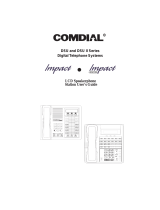
TOC-2
3.6.1 Camping On - Idle Station, Automatic Callback ............ 31
3.6.2 Camping On - Busy Station, Wait For An Answer
(Call Waiting)................................................................. 32
3.7 Sending Subdued Off-Hook Voice Announcements
(SOHVA) ..................................................................................33
4. Advanced Call Handling ..................................................... 35
4.1 Waiting For A Line (Queuing) .................................................35
4.2 Conferencing ............................................................................36
4.3 Call Forwarding ........................................................................38
4.3.1 Forwarding a Call............................................................ 38
4.3.2 Diverting All Incoming Calls To Another Station.......... 40
4.4 Call Forward Outside System (CFOS) .....................................40
4.5 Call Parking ..............................................................................43
4.5.1 Parking a Call .................................................................. 43
4.5.2 Handling Park Recalls..................................................... 44
4.6 Call Transferring .......................................................................45
4.6.1 Screened Call Transfers .................................................. 45
4.6.2 Unscreened Call Transfers .............................................. 46
4.7 Other Call Transferring Options ............................................... 47
4.7.1 Hot Transfer .................................................................... 47
4.7.2 Quick Transfer................................................................. 48
5. Nonverbal Messaging ......................................................... 51
5.1 LCD Message Delivery ............................................................51
5.2 Message Waiting Light and Messaging .................................... 54
5.3 Response Message Delivery .....................................................55
6. Programming ...................................................................... 57
6.1 DSS Numbers ........................................................................... 57
6.2 Speed Dial Numbers .................................................................58
6.3 Feature Access Codes ...............................................................60
6.4 LCD Feature Buttons ................................................................ 62
6.5 Reminder Alert .........................................................................65
6.6 Response Message Button .......................................................67
7. Other Advanced Features .................................................. 69
7.1 Background Music ....................................................................69
7.2 Line Groups .............................................................................. 70
7.3 Do Not Disturb Condition ........................................................71
7.4 Automatic Redial ...................................................................... 72



























